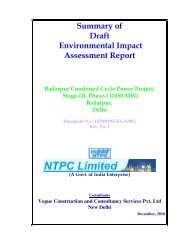proposed integrated complex for delhi judicial academy
proposed integrated complex for delhi judicial academy
proposed integrated complex for delhi judicial academy
You also want an ePaper? Increase the reach of your titles
YUMPU automatically turns print PDFs into web optimized ePapers that Google loves.
Rapid Environmental Impact Assessment (REIA) Study <strong>for</strong> Proposed Integrated Complex <strong>for</strong> Delhi Judicial Academy,<br />
National Law School, and National Institute <strong>for</strong> Mediation & Conciliation at Dwarka, New Delhi<br />
The record shows that over the last few years, the levels of SO 2 have drastically come down<br />
in the ambient air of Delhi. Annual mean SO 2 levels were observed as 18.03 µg/m 3 , 14.1 µg/m 3 ,<br />
11.3 µg/m 3 in the year 2000, 2001 and 2002 respectively. SO 2 levels decreased by 21.8 % & 19.6<br />
% in the year 2001 & 2002 respectively. The annual mean SO 2 levels in Delhi satisfy the annual<br />
average of National Ambient Air quality Standards <strong>for</strong> residential areas, which is 60 µg/m 3 .<br />
Nitrogen Dioxide<br />
The nitrogen oxides exist in ambient air in various <strong>for</strong>ms viz. nitrous oxide (N2O), nitric oxide<br />
(NO), nitrogen dioxide (NO2), nitrogen trioxide (NO3), nitrogen tetroxide (N2O4) and nitrogen<br />
sesquioxide (N2O5). However, only nitric oxide and nitrogen dioxide that exist freely in air are<br />
important as air pollutants. Generally, the atmospheric concentration of nitric oxide and nitrogen<br />
dioxide are clubbed together and reported as oxides of nitrogen (NOx). The nitric oxide (NO) in<br />
ambient environment is less stable and rapidly gets converted to nitrogen dioxide. The nitrogen<br />
dioxide is considered to be important from the view point of pollution and smog <strong>for</strong>mation,<br />
primarily because of its photo-dissipation effect into ozone and oxidation products of hydrocarbons,<br />
wherever the unburnt hydrocarbon exists in atmospheric air. Sources of oxides of nitrogen are<br />
presented in Figure 4.4.<br />
The figure shows the annual average values of NO2 observed during last six years. Despite, an<br />
increase in the number of vehicles from 1997 to 2002, the NO2 levels have shown an increase from<br />
41.7 to 47.2 µg / m 3 which is not very significant. The annual mean of NO2 levels in Delhi is well<br />
within the annual average of National Ambient Air Quality Standards <strong>for</strong> residential areas, which is<br />
60 µg/ m 3 .<br />
Suspended Particulate Matter (SPM)<br />
The airborne particles or particulate matter (PM) can be solid or comprising liquid droplets of<br />
diameter ranging between 0.002 to 500 micron having a life time in suspension varying from few<br />
seconds to several months. The suspended particulate matter (SPM) are the particles/aerosols<br />
having diameter less than 100 micron that tend to remain suspended in the atmosphere <strong>for</strong> a long<br />
period of time. The particles may be directly emitted into the atmosphere. The sources of PM, SPM<br />
and RSPM/PM10 are given in Figure 4.5.<br />
The figure shows that SPM levels have increased from 363 to 456 µg/ m 3 between 1997 to 2002.<br />
But, SPM levels reduced by 11.4% in the year 2001 and increased again to 19.4 % in the year 2002.<br />
This could be attributed to the adverse meteorological conditions in 2002.<br />
58
















